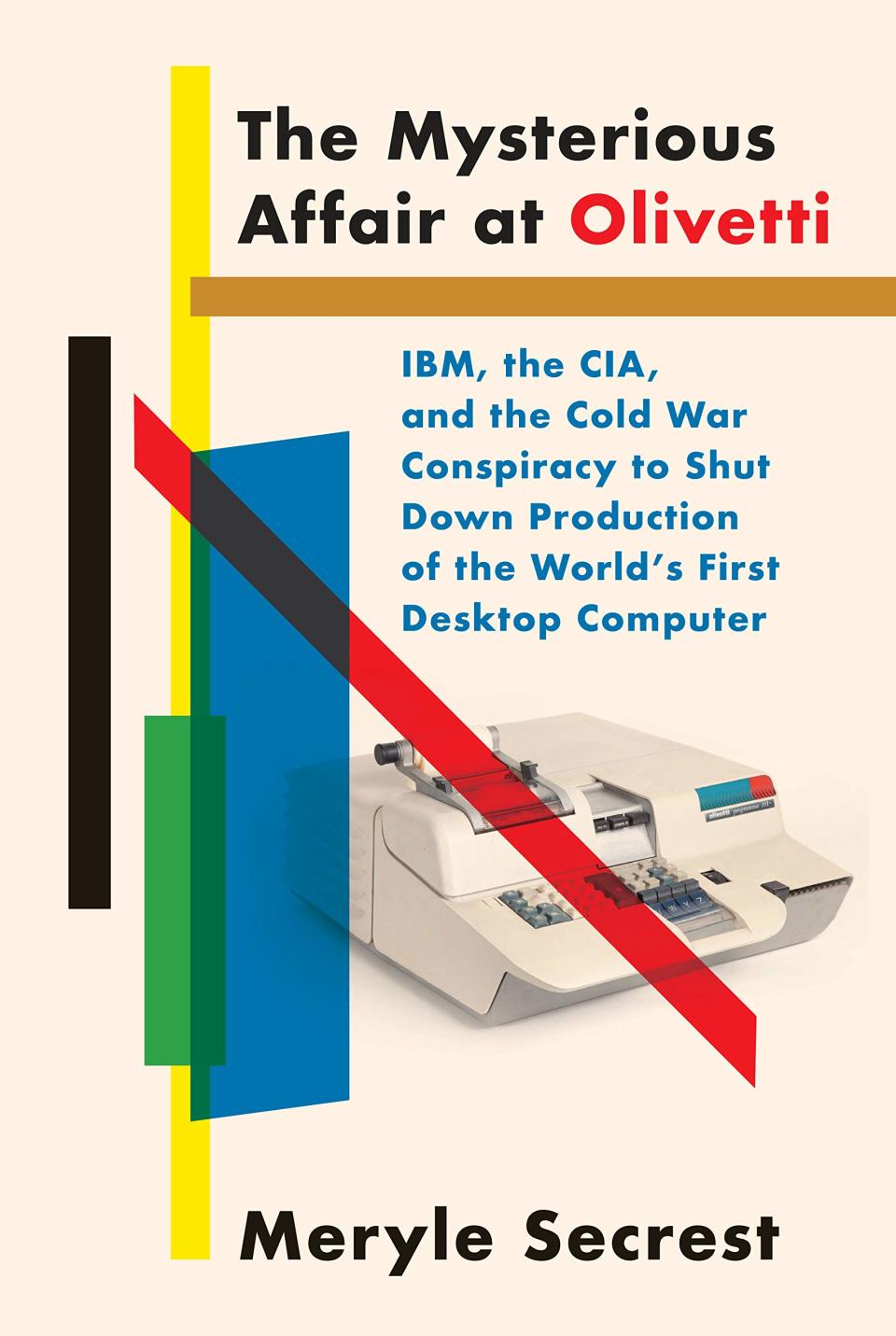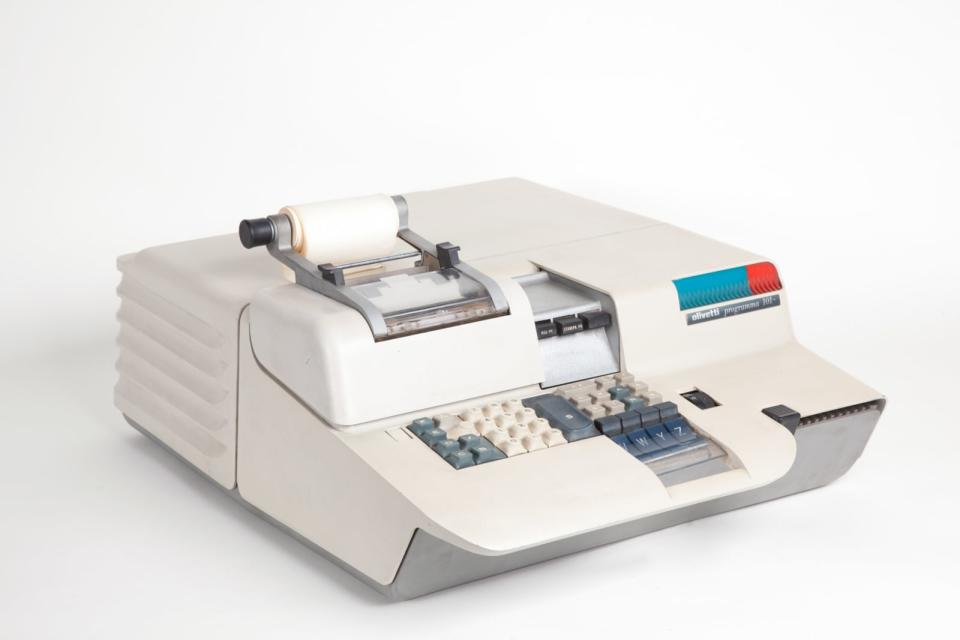Hitting the Books: Did the advent of the first desktop computer lead to murder?
The Olivetti P101 was a hit, and it may well have caused a couple as well.
Welcome to Hitting the Books. With less than one in five Americans reading just for fun these days, we've done the hard work for you by scouring the internet for the most interesting, thought provoking books on science and technology we can find and delivering an easily digestible nugget of their stories.
The Mysterious Affair at Olivetti: IBM, the CIA, and the Cold War Conspiracy to Shut Down Production of the World's First Desktop Computer
by Meryle Secrest

The world's first desktop computer didn't take shape in a Menlo Park garage or the bowels of a corporate production facility. It was created in a workshop in Northwest Italy owned and operated by the Olivetti family. Already renowned for their mechanical typewriters, the Olivetti pioneered electronic calculation a decade before Apple or IBM, which (as you'll read below) debuted at the New York World's Fair in 1964. The first of its kind, the P101, became an instant smash hit -- everyone from NASA to the US military was clamoring for these highly sought after "super-calculators."
But was the Olivetti family's fortune actually a curse? Shortly after the P101's debut, Adriano Olivetti, the head of the family suffered a mysterious and fatal heart attack at the age of 58, just 18 months before the company's talented engineer, Mario Tchou, died in an equally suspicious car accident. In The Mysterious Affair at Olivetti, author Meryle Secrest reveals the incredible behind-the-scenes story of the first desktop computer.
The New York World's Fair was always described in superlatives: 80 nations took part, there were 140 pavilions, 110 restaurants, 45 corporations, and it covered almost a square mile of Flushing Meadows Park in Queens, New York. American corporations and their products naturally took the spotlight. The themes, "Peace Through Understanding" and "Man's Achievement on a Shrinking Globe in an Expanding Universe," were carried out in terms of almost comic-strip Futurism, set in a landscape of parks, walks, lakes, and fountains, dominated by a stainless steel model of the earth twelve stories high. Over 50 million people visited the fair during its two years of existence in the summers of 1964 and 1965, to marvel at the spheroid-shaped pavilion (IBM), its fiberglass tower (7-Up), and its Saarinen-designed restaurants with their innovative fiberglass domes and furnishings.
Olivetti's stand consisted of a huge display of Logos 27 mechanical calculators, adding machines, accounting machines, invoicing machines, and typewriters. In the summer of 1965, the P101 made it to the fair but only just. It was hidden away in a small room behind the main stand. If anyone found it, it was supposed to be an accident. But a few people did. Soon more and more began to squeeze their way in. They wanted to touch the machine. They wanted to feel it. They thought it must be connected to a big machine hidden behind a wall and were amazed to learn it was not. They wanted to play with it. Pretty soon Olivetti salesmen who had been hired to demonstrate the mechanical machines were diverted to the P101. Extra attendants had to be brought in to manage the crowds. Perotto himself, who was always hovering in the background, was pressed into service to show the computer could play games as well. He invented one on the spot and to his delight, he lost. Perhaps the ultimate compliment that autumn was a request from NBC for five P101 computers so as to calculate election results that would be transmitted to millions of viewers in the greater New York area.
Newspapers and magazines such as Fortune, The New York Times, The Wall Street Journal, BusinessWeek, and others groped for ways to describe the new machine. "The first desktop computer in the world," one said. Another, "the machine is filling the gap between the large conventional computer and the desk calculators." A third, with some prescience, predicted there would be "a computer in every office even before there are two cars in every garage." A brilliant idea that evolved in the minds of Roberto Olivetti, Mario Tchou, and Adriano Olivetti a decade earlier had led to this: universal acclaim and so many phone calls and letters that the company was overwhelmed.
The next problem, even if a gratifying one, kept the team up at night. They had assembled about a dozen demonstration machines but going into mass production was another matter, and the problem of logistics was urgent. They were concerned for a number of reasons. Their enemies inside the company would pounce if it turned out that the new machines, once tested in somebody's office, did not work, or only worked once in a while. However, the manpower to make sure they were ready to be sold did not yet exist.
This led to another eleventh-hour save that, once again, put them in the position of acting like conspirators in their own company. They waited until evening, when the plant was closed. Then they talked their way past the guards and into an area of the building where the machines, already crated, were ready to be shipped to the U.S. One by one they removed the machines and tested them to make sure they worked. "We went all through that night and the next, testing, repairing and substituting." One week later the first batch left for America "in perfect working order."
The Programma 101 was the world's first commercial, programmable desktop computer. This groundbreaking version used a keyboard, a printer unit that printed data and instructions, and also a magnetic card reader. Once programmed, this card would store data and programs. These cards were made of plastic, with a magnetic coating on one side and a writing area on the other. They were easy and economical to use; to make use of the program stored on it you simply inserted it into the machine. Its memory of 240 bytes is negligible by today's standards but was then a huge advance over mechanical calculators in terms of speed. And in terms of mainframe computers it had the advantage of being in the office and did not need a cadre of technicians in white coats. You could put it on an office desk (it weighed about sixty pounds), it was easy to use, and it was all yours. The price, in 1965, was $3,000 ($24,500 in 2016 dollars). Not cheap, but attractive enough to be snapped up by eager buyers. Some 44,000 P101 machines were sold. In short, it was a winner.
Among the buyers was the National Air and Space Administration (NASA), which was preparing to land on the moon in 1970 and bought ten copies. David W. Whittle, a programmer for NASA at the Johnson Space Center said, "By Apollo 11 we had a desktop computer . . . an Olivetti Programma 101. It was a kind of supercalculator. It could add, subtract, multiply and divide, [and] also remember a sequence of these things, [recorded] on a magnetic card . . . So you could write a programming sequence and load it in there." He continued, "The Lunar Module high-gain antenna was not very smart; it didn't know where Earth was . . . We would have to run four separate programs on this Programma 101." The computer was also being used by the U.S. Air Force during the Vietnam War to "compute coordinates for ground-directed bombings of targets for the B-52 Stratofortresses." The military had taken note.
Almost the first thing was to take out a copyright for the P101. This turned out to be a wise precaution when, in 1967, barely two years later, the American company Hewlett-Packard brought out its own desktop computer that resembled, in all essential respects, the design of the P101. They put the machinery into its own case, with HP on the label and sold it with its own number. Olivetti launched a copyright suit and was rewarded with almost $1 million in royalties.
For Perotto the P101 was just the "first lonely brick" laid toward what would be a shining road to the future. All that daring, forethought, and subterfuge had led to the startling lead that the P101 then held over every other company. Perotto thought Olivetti had a five-year advantage over the competition. David Olivetti calculated longer -- seven years, a lifetime in the cutthroat business world -- in which to establish a world market, making use of the new semiconductor technology that was the next bold step. It would be a world leader and Ivrea would become its center, for an Italian Silicon Valley.
Roberto was already looking ahead. He had signed an agreement with Fairchild, a company already working in the semiconductor field, to jointly sponsor further research and development, which, in short order, would lead to the development of personal computers on a vast scale. Richard Hodgson, an executive with the Fairchild Semiconductor Company, was enthusiastic. His company would gain the edge in Europe and Olivetti would gain innovative technology that would enhance its stunning advantage. All this took place in September 1959, a few months before Adriano's death. The two men liked each other immediately. Hodgson thought the young Italian was sensitive, and "brimming with youthful vitality," and Roberto saw Hodgson as Mario Tchou's logical successor. But then the objections started and the roadblocks were built by directors and shareholders who, Hodgson concluded, cared only about immediate profits. Visentini scowled. Nothing came of it.
Excerpted from THE MYSTERIOUS AFFAIR AT OLIVETTI: IBM, the CIA, and the Cold War Conspiracy to Shut Down Production of the World's First Desktop Computer by Meryle Secrest. Copyright © 2019 by Meryle Secrest. Excerpted by permission of Alfred A. Knopf, a division of Penguin Random House LLC. All rights reserved. No part of this excerpt may be reproduced or reprinted without permission in writing from the publisher.



